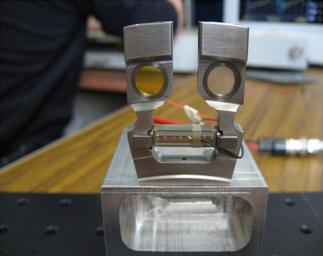
|
Shake it up, CheMin
- Click the image above for a larger view
- Full-Res JPEG (630 x 500) (31.2 kB)
- Full-Res TIFF (630 x 500) (945.5 kB)
Caption:
This image shows the cells that hold the soil samples that are vibrated by the Chemistry and Mineralogy (CheMin) instrument on NASA's Curiosity rover. When the rover delivers samples to CheMin, they are funneled into one of the windowed areas in the cell assemblies. (There are 16 pairs of dual-cell assemblies in CheMin.) These cell pairs act like a tuning fork, vibrated at about 2,000 times per second by a piezoelectric device placed between the two arms of the fork. When vibrated, the particles flow like liquid. This movement enables the instrument's X-ray beams to hit all of the grains in random orientations over time. This innovative technology has been spun off for commercial use in miniaturized portable X-ray diffraction instruments. The powder vibration system enables poorly prepared or as-received samples to be analyzed without further sample preparation. This is useful in cases where extensive sample preparation is either not possible (e.g., on Mars) or when delicate materials (such as pharmaceutical products) would be destroyed or altered by extensive grinding. Implementation of the powder vibration system was a crucial step in enabling small portable X-ray diffraction instruments because many of the moving parts in conventional X-ray diffraction instruments could be eliminated.
Background Info:
NASA's Jet Propulsion Laboratory, a division of Caltech in Pasadena, manages the project for NASA's Science Mission Directorate, Washington, and built Curiosity and CheMin.
For more information about Curiosity and its mission, visit: http://www.nasa.gov/msl and http://mars.jpl.nasa.gov/msl .
Cataloging Keywords:
| Name | Value | Additional Values |
|---|---|---|
| Target | Mars | |
| System | ||
| Target Type | Planet | |
| Mission | Mars Science Laboratory (MSL) | |
| Instrument Host | Curiosity Rover | |
| Host Type | Rover | |
| Instrument | Chemistry & Mineralogy X-Ray Diffraction (CheMin) | |
| Detector | ||
| Extra Keywords | Color | |
| Acquisition Date | ||
| Release Date | 2012-10-30 | |
| Date in Caption | ||
| Image Credit | NASA/Ames/JPL-Caltech | |
| Source | photojournal.jpl.nasa.gov/catalog/PIA16172 | |
| Identifier | PIA16172 | |
